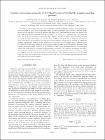| dc.contributor.author | RUNGGER, IVAN | en |
| dc.contributor.author | SANVITO, STEFANO | en |
| dc.date.accessioned | 2014-01-29T10:26:10Z | |
| dc.date.available | 2014-01-29T10:26:10Z | |
| dc.date.issued | 2009 | en |
| dc.date.submitted | 2009 | en |
| dc.identifier.citation | X.Feng, O. Bengone, M. Alouani, I. Rungger, and S. Sanvito, Interface and transport properties of Fe/V/MgO/Fe and Fe/V/Fe/MgO/Fe magnetic tunneling junctions, Phys. Rev. B, 79, 2009, 214432 | en |
| dc.identifier.other | Y | en |
| dc.identifier.uri | http://hdl.handle.net/2262/67937 | |
| dc.description | PUBLISHED | en |
| dc.description.abstract | The interface and transport properties of Fe/V/MgO/Fe and Fe/V/Fe/MgO/Fe magnetic tunneling junctions
are investigated by using density-functional theory and nonequilibrium Green?s-function methods. Bader
analysis reveals that the Fe layer at the interface with MgO loses a small amount of charge with respect to its
bulk value, in contrast to a previous study
W. H. Butler, X.-G. Zhang, T. C. Schulthess, and J. M. MacLaren
Phys, Rev. B
63
, 054416
2001
. At the same time at the Fe/V interface a magnetic moment is induced on the
V layer by proximity. Importantly, the direction of the magnetization of the first V monolayer immediately
close to the MgO barrier oscillates with the total V-layer thickness and the relative stability of a particular
magnetic configuration weakens as such a thickness is increased. These two aspects pose a challenge to the
Fe/V/MgO/Fe device signal stability. A more intriguing situation is found for Fe/V/Fe/MgO/Fe junctions. Their
transport properties depend sensitively on the thickness of the Fe layer intercalated between V and the MgO
barrier. This is the result of resonances through quantum-well states of
1
symmetry localized in the interca-
lated Fe layer. In particular, for some geometries we find a massive magnetoresistance obtained by simply
switching the direction of the magnetization of the Fe interlayer, while keeping the direction of the electrodes
fixed. This effect may be employed in the design of new spin valves with extremely high spin polarization but
still relatively large current densities | en |
| dc.description.sponsorship | The calculations were performed using the CINES IBM
SP4 supercomputer under Computer Grant No. gem1100.
X.F., O.B., and M.A. would like to acknowledge funding
support from the ANR of France Grant No. ANR-06-NANO-
053-01. The
SMEAGOL
project
I.R. and S.S.
was sponsored
by Science Foundation of Ireland
Grants No. 07/IN.1/I945
and No. 07/RFP/PHYF235
. We would also like to thank S.
Lebegue for helping with the
VASP
calculations | en |
| dc.format.extent | 214432 | en |
| dc.language.iso | en | en |
| dc.relation.ispartofseries | Phys. Rev. B | en |
| dc.relation.ispartofseries | 79 | en |
| dc.rights | Y | en |
| dc.subject | density-functional theory | en |
| dc.title | Interface and transport properties of Fe/V/MgO/Fe and Fe/V/Fe/MgO/Fe magnetic tunneling junctions | en |
| dc.type | Journal Article | en |
| dc.type.supercollection | scholarly_publications | en |
| dc.type.supercollection | refereed_publications | en |
| dc.identifier.peoplefinderurl | http://people.tcd.ie/sanvitos | en |
| dc.identifier.rssinternalid | 64907 | en |
| dc.identifier.doi | http://dx.doi.org/10.1103/PhysRevB.79.214432 | en |
| dc.rights.ecaccessrights | OpenAccess | |
| dc.subject.TCDTheme | Nanoscience & Materials | en |
| dc.identifier.rssuri | http://prb.aps.org/abstract/PRB/v79/i21/e214432 | en |
| dc.contributor.sponsor | Science Foundation Ireland (SFI) | en |
| dc.contributor.sponsorGrantNumber | 07/RFP/PHYF235 | en |
| dc.contributor.sponsor | Science Foundation Ireland (SFI) | en |
| dc.contributor.sponsorGrantNumber | 07/IN.1/I945 | en |




